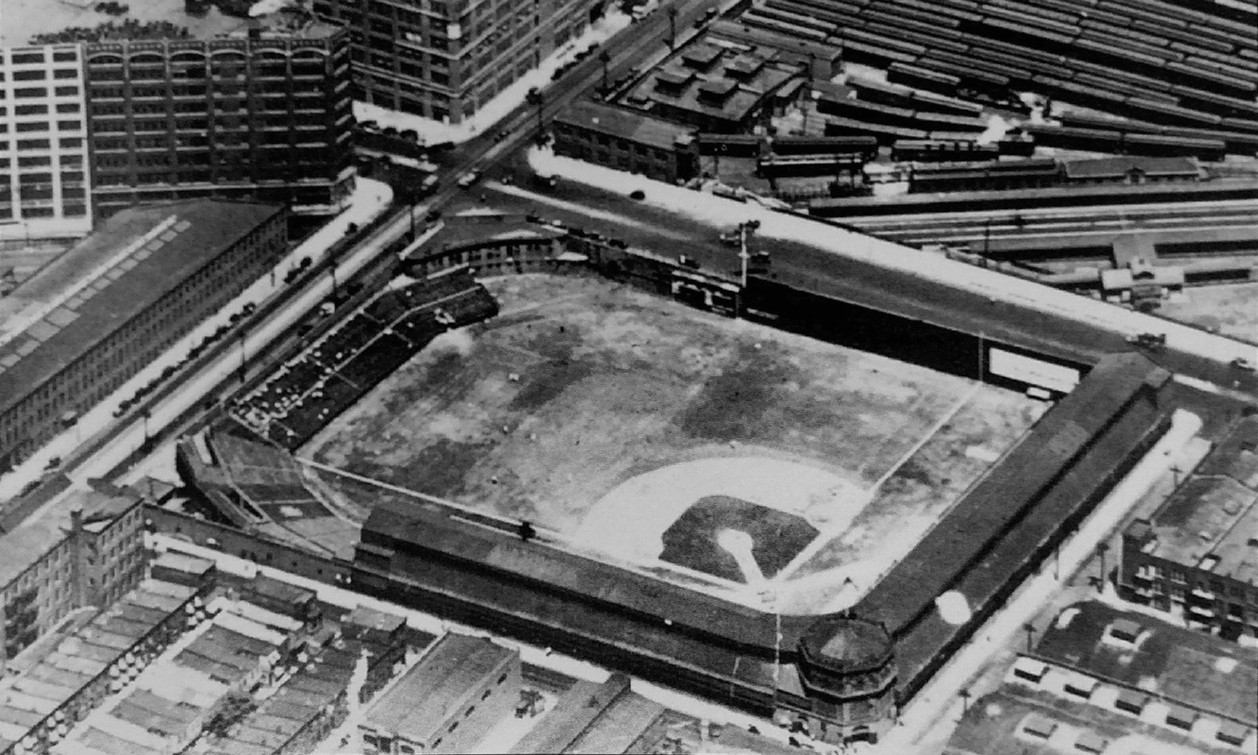The oldest stadium to be featured so far, the Baker Bowl has all the oddities you could want from a ballpark that opened before the dead ball era.
The Bandbox of Philadelphia
The Baker Bowl originally opened in Philadelphia in 1887. At the time, the wooden structure was considered state-of-the-art. It featured a capacity of 12,500.
Unfortunately, this version of the Bowl didn’t even last eight years. A fire caused the entire structure to burn down in 1894. It was rebuilt, this time out of steel and brick.
Like many parks of its time, the dimensions were a bit strange. With the right-field line being just 280 feet away from home plate, a 60-foot fence was constructed. The fence was built out of several different materials, thrown together to hastily increase the height of the wall through the years (it was 40 feet before being raised to 60).

The signature look of the fence includes a gigantic ad for Lifebuoy, a brand of soap. The ad exclaimed, “The Phillies use Lifebuoy”, which often led to a rebuttal, “… and they still stink!“. This was taken a step further in 1936, by a fan who snuck onto the field in order to spray-paint the phrase onto the ad.
There was also a slight hill in center field, covering a railroad track that ran under the outfield. Reportedly, outfielders would feel the ground rumbling when a train passed underneath.
The Phillies’ clubhouse was located past center, and actually made up part of the center-field wall. Legend has it that Rogers Hornsby once hit a ball that broke one of the clubhouse windows.
The Baker Bowl: What’s in a Name?
The name “Baker Bowl” is actually an interesting story itself. The Phillies originally referred to the park as “Philadelphia Ball Park”, eventually calling it “National League Park”. The name “Baker Bowl” first appeared in the Philadelphia Inquirer in 1923, but was never used by the Phillies themselves.
The strange dimensions of the stadium allowed players to hit tall, short fly balls over the right-field fence for home runs. In 1913, the Phillies led the league with 73 home runs. Teammates Gavvy Cravath and Fred Luderus were first and second, respectively, in the league in homers.
This led to some sizable criticism from opponents, who felt that the short distance to right field allowed for cheap homers. Sam Miller, a writer for the New York Globe, said, “It is not surprising that the Phillies hit 73 home runs. The wonder is that they don’t hit 100.”
The Baker Bowl: Odds and Ends
The Philadelphia Eagles also called the Baker Bowl home from 1933 to 1935. The capacity was expanded by 5,000 for Eagles games due to additional seating put up in right field. The Eagles had little success at the Bowl, going 9-21-1, and they moved to Philadelphia’s Municipial Stadium (a.k.a. JFK Stadium) for 1936.
The Baker Bowl was nestled between residential streets, which was not uncommon for ballparks of the time. This resulted in many foul balls and home runs landing out of the park completely, and into the surrounding streets.
This gave birth to a local legend. “Ball Hawk George” became known for his ability to track down the numerous foul balls hit out of the Bowl. According to the SABR bio of the Baker Bowl, “George knew from the sound of the bat whether it was a foul ball”.
Babe Ruth also hit at the stadium just twice in his career: once as a pinch-hitter in the 1915 World Series, and again as a 40-year-old Boston Brave in his final career at-bat.
The End of the Baker Bowl
The Phillies didn’t experience much success in their time at the Baker Bowl. Their lone pennant came in 1915, where they lost to the Boston Red Sox in the World Series. It was the first postseason appearance for Babe Ruth, and the last World Series to be played in a park that was built before the Series first began.
For the final 20 years of the park’s existence, the Phillies didn’t achieve much. At the same time, the Baker Bowl was slowly becoming outdated. It had a small capacity (18,800) and the stadium was physically crumbling.
The final game at the Baker Bowl was played between the Phillies and Giants on June 30th, 1938. It was an unceremonious ending, with the Giants winning 14-1. In a way, it was a fitting way for the Baker Bowl’s time to end.
Mid-season, the Phillies packed up and moved across town to Shibe Park. Here, they shared the field with the Philadelphia Athletics, managed by Connie Mack.
The Baker Bowl was demolished in 1950. It was designated as a Pennsylvania historical landmark in 2000. The Phillies remained at Shibe Park until 1971, when they moved to Veterans Stadium. In 2004, the Phillies moved into the charming Citizens Bank Park, where they have played ever since.
(Info from SABR, Ballparks of Baseball, and Baseball Almanac)
The Baker Bowl: Specs
Opened: 1887
Closed: 1938
Capacity:
- 12,500 (1887-1894)
- 18,000 (1895-1928)
- 20,000 (1929)
- 18,800 (1930-1938)
Dimensions:
- Left Field: 342 feet
- Center Field: 412 feet
- Right Field: 281 feet




